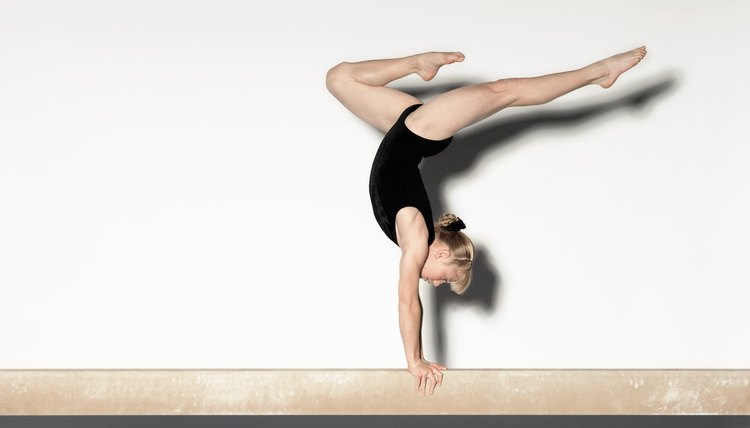Muscles That Gymnasts Use

It is easy to believe that gymnasts use every muscle in the body. They leap, spring, bound, flip and handstand. They not only use every muscle, but also use them in every way a muscle can be used.
Legs
The many positions the body moves through during the back handspring are used on every apparatus. During the back handspring takeoff and landing, the quadriceps and gluteal muscles produce the most power. The quadriceps muscles are called vastus lateralis, vastus medialis, vastus intermedius and rectus femoris. The main buttocks pushing muscle is called the gluteus maximus. The muscles that squeeze the legs together through the upside-down phase are adductor longus, adductor magnus, gracilis, pectineus and adductor brevis. The main muscles of the lower legs that a gymnast uses constantly to point, flex and jump are gastrocnemius, soleus, peroneus longus, extensor digitorum longus, peroneus tertius, extensor digitorum longus, flexor digitorum longus, tibialis anterior and tibialis posterior.
Core
Abdominal and pelvic muscles are used in every movement a gymnast does. In the back handspring, they contract to pull the legs and pelvis over the top. This abdominal contraction and hip flexion is also used throughout a gymnastics routine. The abdominal muscles are called the rectus abdominis, transversus abdominis, external oblique and internal oblique. Other key pelvic muscles are psoas major and psoas minor, iliopsoas and iliacus. The opposite motion, which raises the torso up to standing, uses the muscles of the lumbar vertebrae, pelvis and legs. They are called erector spinae, gluteus maximus, semitendinosus, biceps femoris and semimembranosus. Some of these muscles have already been named. That is because some do multiple jobs.
Arms, Chest and Back
The muscles of the arms, chest and back work together to assist and oppose each other. They are all solicited in the back handspring to pass through handstand position and push off the floor. This motion is repeated throughout a gymnastics routine. Main muscles used in the mid and upper back are called trapezius, latissimus dorsi, infraspinatus, supraspinatus, subscapularis, teres minor and teres major, rhomboideus major and levator scapulae. The cooperating muscles of the chest and shoulders are called serratus anterior, pectoralis major and minor, and anterior, medial and posterior deltoids. The upper-arm muscles that reach and push through the upside-down and right-side-up back handspring motion are the triceps, biceps and coracobrachialis.
Other
A gymnast's forearms and neck muscles play an important role, especially since the body follows the head, and the neck moves the head. A gymnast's forearms require significant strength for grasping and holding body weight. Muscles of the neck used in gymnastics are sternocleidomastoid, scalenus, splenius capitis and semispinalis capitis. The forearm muscles are supinator, pronator teres, brachioradialis, flexor carpi radialis, palmaris longus, flexor carpi ulnaris, extensor carpi radialis longus, extensor carpi radialis brevis, extensor digitorum, extensor carpi ulnaris and pronator quadratus.
Writer Bio
Lynne Shaw has been a professional writer for more than 15 years. She additionally enjoyed a long career in news/talk radio production and anchoring. Her articles have appeared in numerous national and regional publications. She is a contributor in "Chicken Soup for the African American Woman's Soul."
